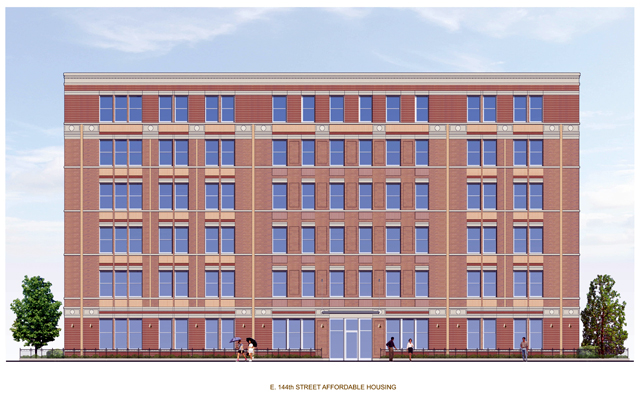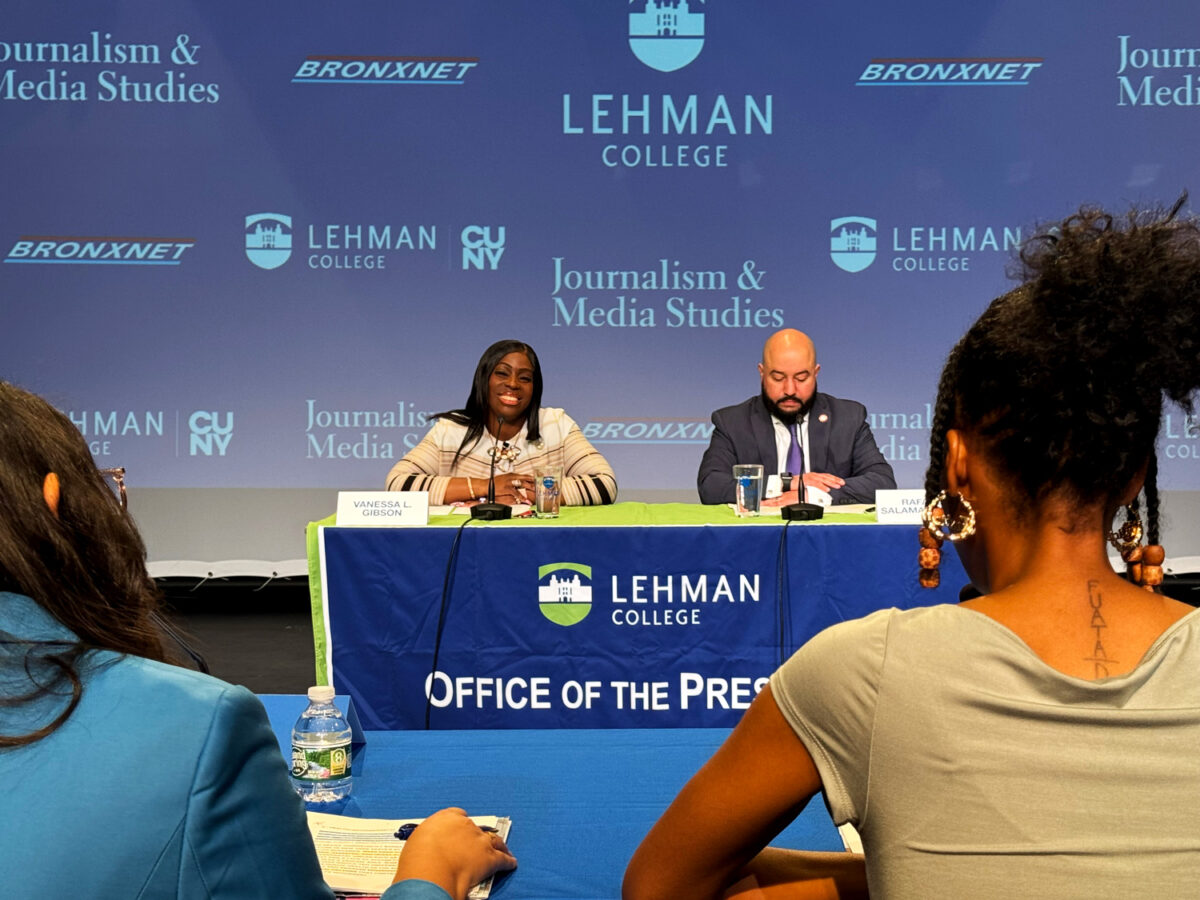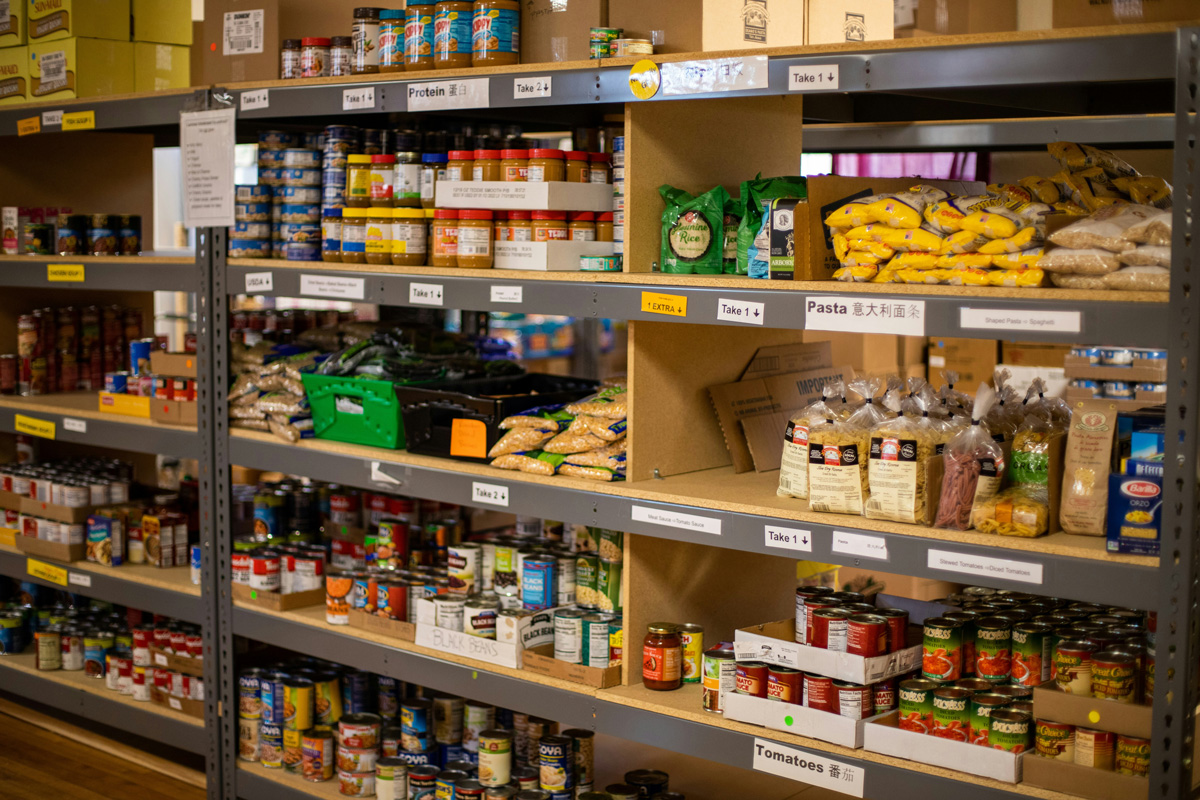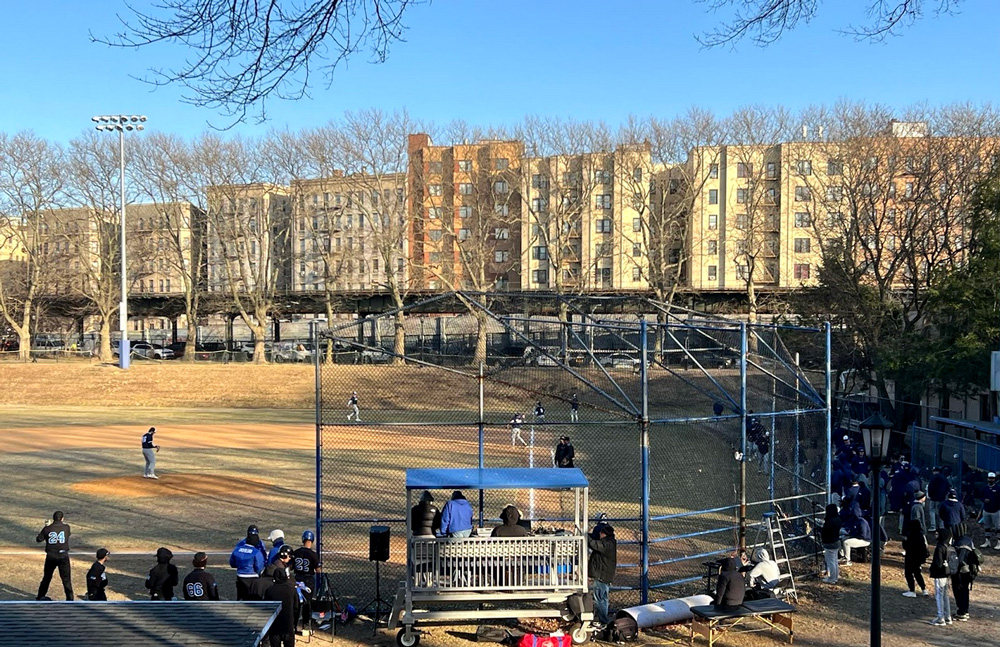By Percy D. Luján
The Bronx Journal Staff
In the Mott Haven neighborhood of the South Bronx, homeowners, a non-profit organization and the state are clashing over a proposed housing facility that will include units for the mentally ill.
The homeowner organization, We Are Mott Haven, is trying to prevent the non-profit Association for Rehabilitative Case Management and Housing (ACMH) from continuing with a 60-unit project that would include 42 housing units for people who suffer from mental illness.

We Are Mott Haven member Dr. Marian Rivas speaks to other neighbors.
“It is very near schools, and many families, many children walking through,” said We Are Mott Haven member Ana Maldonado as she talked to other neighbors during a March community meeting. “Enough is enough and we have to stand up and let people know we don’t need more of this.”
The organization says there is an “over saturation” of similar programs in a small geographically enclosed residential area.
Community Board 1 – which is made up of parts of the neighborhoods of Mott Haven, Melrose and Port Morris – is bordered by the Harlem and East Rivers, and also surrounded by the Major Deegan and Bruckner Expressways.
The facility is to be constructed on an empty lot between 143rd and 144th Streets near Saint Mary’s Park. The project received funding from the New York State Office of Mental Health (OMH).
Daniel K. Johansson is the executive vice president and CEO of ACMH. Some weeks ago, he stood at the site where the new facility will be: a six-story brick building of the same color of the building next door.
Not long after, a neighbor approached Johansson and asked him when they would start building. Then, other neighbors began to join in with contentious questions. Among them was homeowner Dr. Marian Rivas who lives nearby in an 120-year-old home.
We Are Mott Haven homeowners have a history in the neighborhood. During the Bronx housing crisis of the 70s, they stayed in their properties as the surrounding neighborhood burned.
“Do you have any idea how much we have gone through to fix this neighborhood?” Rivas asked Johansson. “You are throwing us back to the past.”
Other residents peppered Johansson with questions such as: Why did they pick Mott Haven for the facility? Will the residents be able to move in and out of the building freely? What will parking be like and what security measures will be implemented?
A project summary provided by Johansson said that 20 studios in this new facility will be given to 18-to-24 year-olds who would be “transitioning out of residential treatment, foster care or psychiatric centers.” The summary said that “[t]hese are individuals who could live independently in the community if provided with supportive housing.”
Rivas’ concern is that out of the 42 housing units for people with mental illness, 20 of those will be young adults who would be living alone for the first time. The rest of the units will go to low-income residents.
Rivas told Johansson that he would be putting 18-to-24 year-olds into “a high risk area.” She said that these young adults would be vulnerable because people would try to buy their medication. “You put them in a neighborhood where drugs are rampant,” Rivas said.
Johansson said that the residents would be provided with a counselor and a job developer. The proposal also states that the facility will have a “library, computer study, laundry room, bicycle storage” as well as full-time on-site property managers, a superintendent and a porter. Johansson told the neighbors that the staff would be hired from the surrounding community.
He also tried to reassure them that those with mental illness issues are functioning, since they participate in vocational programs or are going to school.

A sketch of the proposed facility that neighbor Marcelino Sanchez describes as “an ugly box.”
Johansson explained it was Lincoln Hospital that contacted them to develop permanent supportive housing for people with mental illness. The corporate structure of The Bronx-Northern Manhattan Network of the New York City Health and Hospitals Corporation then provided support for the project.
He later told the neighbors that they would have medical staff to make sure that the occupants stay on their medication. He also said that they will conduct a criminal background check on everyone who goes to live there.
But residents aren’t buying it.
Rivas said she doubted the ability of the young adults who come to the facility to have control of their lives and to behave around the residents who do not have mental illness. Johansson replied: “When you mix people, and you expect them to behave like adults, they usually do.”
Rivas told Johansson that the neighborhood had the lowest rate of disabilities in the Bronx. “How come you are not going to Riverdale?” Rivas asked.
“There is no need for it,” he answered.
A chart made by We Are Mott Haven based on data from “Selected Facilities and Program Sites” city survey shows that Bronx Community Board 1 contributes 10.5 percent of the total of residential services for chemical dependency, mental health, developmental disabilities and homeless services.
According to the data, 79.3 percent of these services are in Community Boards 1 through 6. The breakdown is as follows:
* 88.7 percent of residential units for the homeless are in Community Boards 1-6 versus 11.1 percent in Community Boards 7-12
* 97.4 percent of residential services for people with chemical dependency are in Community Boards 1-6 versus 2.6 percent in Community Boards 7-12
* 76.6 percent of the residential units for people with mental illness are in Community Boards 1-6 versus 23.4 percents in Community Boards 7-12
There is one exception to this trend. The data shows that Community Boards 7-12 have 73.7 percent of residential services provided for people with developmental disabilities, compared to 26.3 percent in Community Boards 1-6.
Community Board 8, that includes Riverdale, contributes 1.8 percent of the residential services in the Bronx.
* It contributes 0 percent of residential units for the chemically dependent, compared to the 13 percent provided by Community Board 1.
* It contributes 0 percent of the residential units for the homeless, compared to 12.7 percent provided by Community Board 1.
* It does, however, contribute 11.7 percent of the residential units for people with developmental disabilities, compared to the 4.5 percent in Community Board 1.
* It also contributes one percent of the residential units for people with mentally illness, compared to the 5.8 percent in Community Board 1.
This is even though Community Board 8 had around 19,170 more people than Community Board 1, according to statistics by the Department of City Planning in 2000.
We Are Mott Haven argued in a letter sent to Governor Andrew Cuomo early in February that there are 266 proposed and operational housing units for the mentally ill in Community Board 1. That constitutes 0.3 percent of the total population of this area. These projects are funded by the Office of Mental Health (OMH) and the Department of Health and Mental Hygiene (DOHMH).

The empty lot in which the facility is to be built between 143rd Street and 144th.
The letter also says that Community Board 8 in the Northwest section of the Bronx – which according to the Department of City Planning had a population of 101,332 in 2000 – only has 15 supportive residential units or around 0.015 percent of their population.
It continues, saying that even though Community Board 10 and 12 have more people than Community Board 1, these have a smaller percent of supportive residential units in relation to their populations. The organization said that Cuomo did not respond to the letter.
Another chart, also provided by We Are Mott Haven, shows that Community Board 1 contributes 49 percent of all the mental health outpatient services, making it by far the greatest contributor of these services in the Bronx.
In addition to this appeal to Governor Cuomo, the organization sent letters to numerous housing officials and Bronx politicians, Rivas said at the March community meeting. Johansson also mentioned that the community leaders were sent letters explaining the project before it was approved.
“They were all sent letters, and they all chose to ignore it,” said homeowner Marcelino Sanchez as he recounted the meeting with Johansson during the March meeting. He said that these community leaders didn’t notify their communities once they knew about the project.
We Are Mott Haven also contacted Bronx Borough President Ruben Diaz, Jr., OMH Commissioner Michael F. Hogan, and the New York State Homes and Community Renewal Commissioner Darryl C. Towns. Members met with Towns early in February. They said that he was trying to get the residents to negotiate with ACMH, something the residents refused.
State Assembly Member Carmen Arroyo, who represents the 86th District, which includes Mott Haven among other neighborhoods, then wrote a letter to Governor Cuomo, Rivas said, asking him to come down to the neighborhood, but Cuomo never came.
The residents also met with Bronx Borough President Ruben Diaz, Jr., at the beginning of April. According to Rivas, the meeting “went well” and that they presented him with new information substantiating their viewpoint.
Several emails sent to the offices of Commissioner Towns, Commissioner Hogan and President Diaz by The Bronx Journal did not yield significant replies.
As he spoke to the homeowners in front of the site, Johansson showed them a drawing of what the building would look like, saying it was going to be a beautiful building. Sanchez responded, “It is an ugly box.”
Rivas told Johansson that she read in academic journals that supportive housing doesn’t work. “There is no guarantee they will stay in supportive housing,” she said.
Sanchez told Johansson that the people without mental illness who move in would move out within a month. “When they see that the people who are living here are lunatics, they are going to move out,” he said.

We Are Mott Haven neighbors in a community center.
“They are not lunatics,” replied Johansson. “They are human beings.”
Sanchez later said that he believed the reason many people may act erratically is because of the drugs they were administered to treat their mental illness.
“Look,” said Sanchez, “you are a true believer. I admire that. But you have to see our end on this. Government is against us. Private enterprise is against us.”
Sanchez had said previously that in a neighborhood where politicians care about their people, they don’t have these kinds of controversial facilities.
“You don’t lose anything. We do,” Sanchez told Johansson. “This is going to be a hell of a learning experience for you.”
The neighbors argued with Johansson about the building abutting one home’s backyard.
The homeowners also worry about the proximity of the project to the schools around the area like the South Bronx Head Start Program and the Bronx Charter School for Children which are about a block from the facility.
“Good luck to you, but this is not a done deal yet,” another neighbor, Luis Melendez, told Johansson, saying they will fight until the end.
“And I will fight for my people,” Johansson replied, “people with disabilities.”
At the March meeting, resident Carmen Santiago said to the others that if they wanted to see how the neighborhood was going to change, they had to walk to the supportive housing facility at the corner of 148th and Brook Avenue known as The Brook.
She said that the workers inside the building let the inhabitants hang outside, even when they have a green courtyard and a green roof provided inside the facility. “They are outside hanging out, doing their traqueteo,” she said.
“This is a racial and social neighborhood profiling,” Santiago said. “We’ve been profiled socially as the poorest district in the country. ‘Who cares? They are not educated. They are poor anyway. Let’s just dump everything on Community Board 1.’”










Shabel Castro | May 13, 2012
|
Excellent Articles